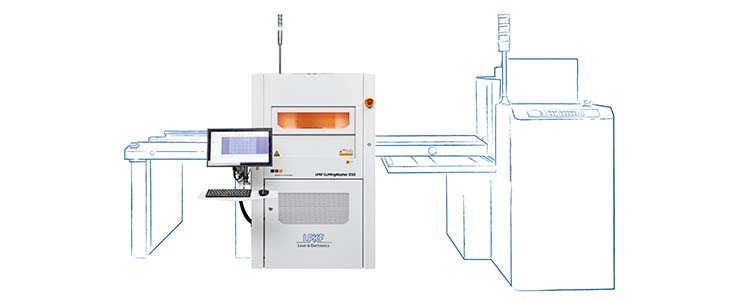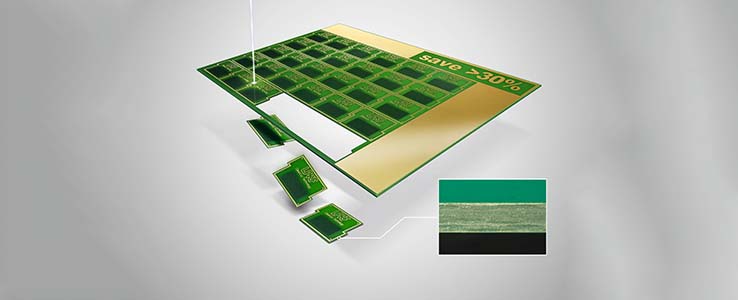© LPKF
General |
Depaneling With Laser Technology
How was it possible to save money here these days? And what actually were the advantages and disadvantages of laser technology? For the answers to these questions, read our interview below.
EDITOR'S NOTE_ This is a guest article from LPKF Laser & Electronics AG. The author is solely responsible for the content.Q: The corona pandemic is not over yet – how does the near future look for LPKF? Roman Ostholt: Because of the pandemic, we – like many other companies – have found new ways to be there for our customers. We will definitely be retaining some of them after the pandemic is over. After more than a year, however, all our employees are looking forward to being able to meet their customers and colleagues in an “analog” way. Due especially to accelerated vaccination campaigns worldwide, we are seeing a mood of optimism everywhere. We are looking to the future with much more confidence now than half a year ago. Q: Many companies took advantage of the extraordinary situation and pressed forward with the development of new products. We have heard that at LPKF, too, an expanded product portfolio is contributing to the positive outlook. R. O.: That’s correct. Despite the pandemic, we worked tirelessly to develop new solutions, which we are now or will by the end of the year be introducing on the market. We started with the rollout of customized automation solutions for our depaneling systems. Through this, both we and our customers can respond flexibly to changing handling tasks. The next thing in the starting block is the LPKF CuttingMaster 2122, a new laser system for depaneling. Q: LPKF has already been known for years for its laser systems for depaneling. Is there anything that can still be improved? What characterizes the new system? R. O.: Well, we have reduced the costs per millimeter of cutting length by more than 10 times over the last ten years. Nearly all of our current and future innovations have at their core the aim of further improving the price-to-performance ratio for our customers. The CuttingMaster 2122 embodies precisely this strategy: compared with the predecessor model, it offers an up to 25% higher cutting speed and – we are especially proud of this – at the same costs for our customers. Q: How are you positioned in relation to other vendors? R. O.: Like you already said, we have been involved in laser depaneling for a very long time now and have been very successful with it in all regions of the world. Even today we can also already call ourselves the world leaders in laser-based depaneling solutions. This also has to do with the fact that as a technology company with integrated laser development, we also use our own laser sources here and can thus offer a better price-to-performance. Q: Why, then, have you once again adjusted the price-to-performance ratio? R. O.: In the past, depaneling with the laser was a solution that you mainly used for special applications in which the properties of the laser were indispensable, for example, for realizing complex geometries or guaranteeing freedom from dust. Up to now, for all other applications, the fast, inexpensive, and hence favored machine has been the router. Today we can offer a price-to-performance ratio for laser systems that can make depaneling with a milling machine obsolete. Q: That’s an ambitious goal. R. O.: Not really. The superiority of depaneling with LPKF lasers is evident today in nearly all technical aspects: cleanliness, accuracy, no induced stress, flexibility. Nobody really questions that anymore. However, many customers view the topic of depaneling quite dispassionately – kind of according to the motto “The printed circuit board has to be depaneled; it’s great if there are technical advantages, but it cannot cost more than my previous process.” While this often spoke against our technology in the past, things are turning around more and more now. Q: You addressed the technical advantages. There are still some reservations here and there about laser cutting. For example, what is the situation regarding carbonization? R. O.: They can, in fact, still be found: the three big myths surrounding laser depaneling, as we like to call them internally. They relate to speed, costs, and carbonized cut edges. Myths – to which there is indeed often a grain of truth – can only be dispelled by facts. Example: carbonization. Naturally, with a sufficiently powerful laser, you can char a printed circuit board. But you don’t have to; and that is not at all inevitable with cutting. Our LPKF CleanCut cuts printed circuit boards without any form of carbonization. We have also had this confirmed by an independent body. Q: Can’t your competitors do that just as well? R. O.: I would really welcome any competitor who could deliver a convincing first article inspection. In our experience, however, the customer will start looking around for alternatives at the latest with the second machine to achieve the optimum in quality and performance lastingly at a reasonable cost. We can score with our superior price-to-performance ratio here. However, I do get annoyed with some competitors, who – maybe without the laser expertise that LPKF has – tell their potential customers, “It doesn’t work any better with a laser as a depaneling tool.” Here, I can only advise all users to let LPKF do the first article inspection – we can do it better. Q: What about the thermal stressing of the components? R. O.: The situation is similar here: if the process is controlled correctly, the temperature rise in the components is completely uncritical; we also have scientific studies for this. Q: It’s said time and again that the laser is only economical for flex circuits. Is there any truth to this hypothesis? R. O.: The statement is based on data from ten years ago and experiences from even before then. Today it’s long outdated. Even 1.6 mm FR4 material can be economically depaneled with the laser. Q: What do you see as being the long-term trends in the field of depaneling? R. O.: First of all, the demands will become higher. More and more end customers are taking a closer look at which problems in the service life of a product might be able to be traced back to the singulation. The cut quality is an important criterion here. That, of course, suits us very well. Besides that, the drastically reduced total costs of laser depaneling are paving the way for laser full-perimeter cutting. Regarding this, you also have to know that nowadays nearly all populated boards are still singulated via tab cutting from prerouted panels, regardless of whether depaneling is done by laser or router. However, printed circuit boards are – and this is still an important trend – becoming smaller and smaller, as a result of which the material loss from milling paths around the perimeter for separation is increasing proportionally. With laser full-perimeter cutting, prerouting of the printed circuit board contour is done away with completely. Through the narrower cutting path of laser cutting and the smaller edge clearance for components that is possible due to the stress-free machining and the fineness of the laser, significantly more printed circuit boards can now be yielded from one panel. Beyond that, more printed circuit boards can be placed on a panel through more flexible cutting geometries. Both save money – both on the printed circuit board level and on the level of the process steps, the costs of which scale linearly with the number of panels. Q: The further development, then, is primarily controlled by the cost factor, but whether it is worth it to switch to laser technology seems to depend on the individual case. Do you have a tip for an independent decision aid? R. O.: Laser full-perimeter cutting offers, besides the cost advantages, the possibility of more resource-efficient manufacturing. As you already noted, layout and panel size are contributing factors determining the effectiveness of laser full-perimeter cutting. We have put our “Panel Layout Optimization Tool” (PLOT) online for customers who want to calculate how great the advantage can be for them. I can only encourage everyone to try it out. Author: Dr. Roman Ostholt, Managing Director of LPKF



